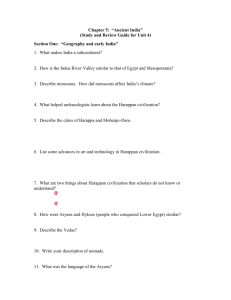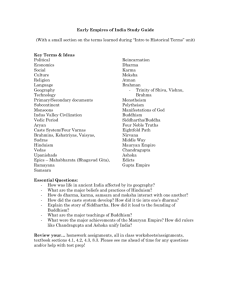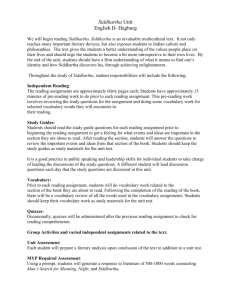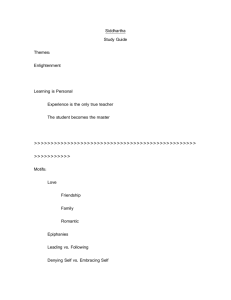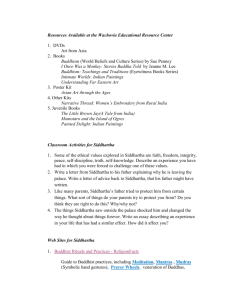Siddhartha Background
advertisement
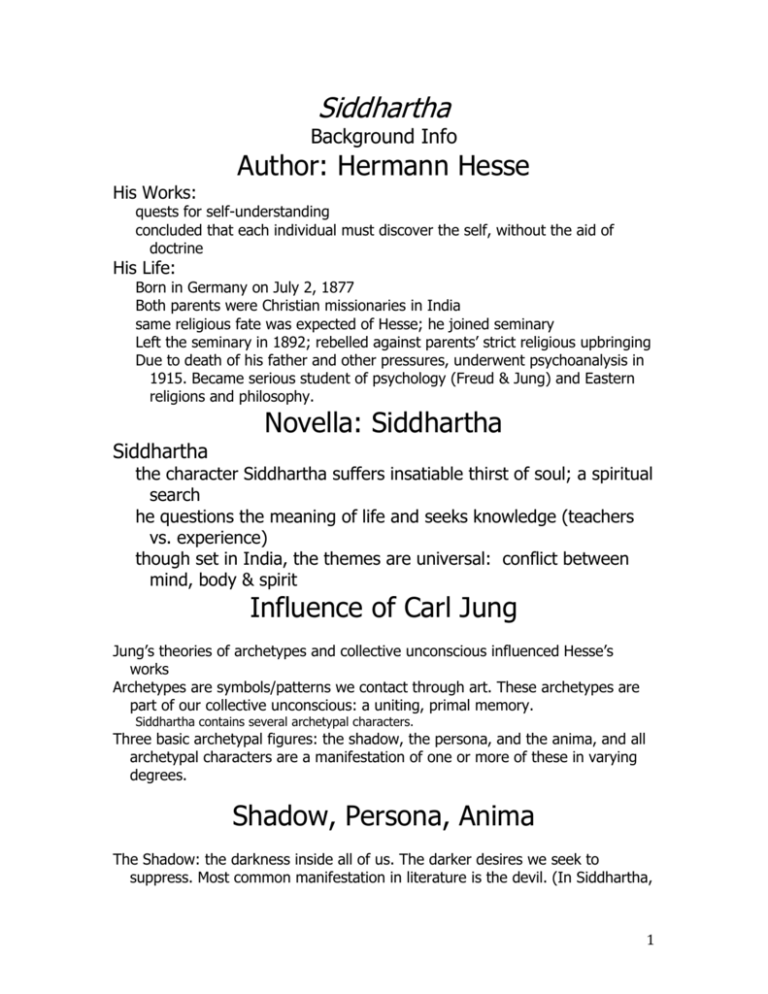
Siddhartha Background Info Author: Hermann Hesse His Works: quests for self-understanding concluded that each individual must discover the self, without the aid of doctrine His Life: Born in Germany on July 2, 1877 Both parents were Christian missionaries in India same religious fate was expected of Hesse; he joined seminary Left the seminary in 1892; rebelled against parents’ strict religious upbringing Due to death of his father and other pressures, underwent psychoanalysis in 1915. Became serious student of psychology (Freud & Jung) and Eastern religions and philosophy. Novella: Siddhartha Siddhartha the character Siddhartha suffers insatiable thirst of soul; a spiritual search he questions the meaning of life and seeks knowledge (teachers vs. experience) though set in India, the themes are universal: conflict between mind, body & spirit Influence of Carl Jung Jung’s theories of archetypes and collective unconscious influenced Hesse’s works Archetypes are symbols/patterns we contact through art. These archetypes are part of our collective unconscious: a uniting, primal memory. Siddhartha contains several archetypal characters. Three basic archetypal figures: the shadow, the persona, and the anima, and all archetypal characters are a manifestation of one or more of these in varying degrees. Shadow, Persona, Anima The Shadow: the darkness inside all of us. The darker desires we seek to suppress. Most common manifestation in literature is the devil. (In Siddhartha, 1 the protagonist has to experience this side of himself in order to become whole). The Anima: the life force in us. In men, the anima takes on a feminine quality and in women, a masculine quality (known as the “animus”). Your “anima/animus” is your image of the ideal person of the opposite sex. According to Jung, these characteristics are typically unconscious. (In Sidd, we see this in Sidd’s dream of Govinda, and later in Kamala). Shadow, Persona, Anima The Persona: the mask we wear in society. Mediates between the ego and outside world. Anima and Persona make up the ego. (Siddhartha essentially tries to obliterate his persona in order to gain access to his anima, but in doing so, suppresses and thus is unable to fully realize his Self until later) In Jungian terms, to become individuated, you must recognize all aspects within yourself that distinguish you from others. When persona is in harmony with this individuated self, you are self-actualized and on the road to perfection. (Thus we, and Siddhartha, must acknowledge and accept our shadow and our anima(us) and not mask these with our persona before we can find harmony.) Joseph Campbell’s Monomyth Cycle and The Quest Three common elements to the Quest: 1) The Departure: there is a quester(s) who is in need of achieving a goal. The goal may be to reach a destination (LotR), to retrieve some treasure (The Holy Grail), or to fulfill some command or task (The Odyssey). 2) The Initiation: the quester(s) will encounter difficulty along the way and there is usually some final test when the destination is reached. 3) The Return: the quester(s) returns home. Siddhartha does not necessarily fulfill all of these characteristics, but the archetypal lens is a useful one through which to view the work. Existentialism Existentialism = (this is the brief, brief version) 1. no predetermined nature that controls what we are, what we do, or what is valuable for us 2. we are radically free to act independently of determination by outside influences 3. we create our own human nature and values through free choices 2 Hinduism Often referred to as the oldest religious tradition. 1. Major Scriptures: Vedas Upanishads Bhagavad Gita The novel Siddhartha parallels the Bhagavad Gita; they answer the same question: how can the individual attain enlightenment (happiness and serenity)? Bhagavad Gita: 3 stages to enlightenment: action, knowledge, wisdom Siddhartha: 3 stages to enlightenment: innocence, knowledge (sin), awareness/consciousness Hinduism 3. General (and I mean general) beliefs The spirit or soul is referred to as “atman” and it is believed to be eternal There is a supreme being (or god, if you will) called “Brahman” The “Atman” is one with “Brahman” If you are enlightened and become supremely aware of your “Atman” then you can escape this world and achieve “moksha” or, in other words, freedom If a soul never reaches “moksha” then it will be reincarnated Hinduism 3. General beliefs All the acts you do on earth are known as “karma” – ultimately what goes around, comes around. Your “karma” affects your life, your personality, and your ability to attain “moksha” The cycle of karma, birth, death, and reincarnation is called “samsara” or “the wheel” Buddhism 1. History of Buddhism Buddhism was born out of Hinduism; it began with a Hindu man named Siddhartha Gotama. Siddhartha Gotama, became known as Buddha, meaning the "Illustrious One" or "Enlightened One." He founded Buddhism in approximately 500 B.C. Raised as a Brahmin prince, he lived a comfortable life full of luxuries, but he was not content. He saw that people outside his palace were suffering and dying. 3 Buddhism 1. History of Buddhism At the age of twenty-nine, he left home against his parents' will and began a spiritual quest first trying out asceticism and then meditating until he achieved enlightenment at age 35. He then began teaching his philosophies until his death at age 80. Buddhism 2. General Teachings of the Buddha Like Hinduism the goal is to achieve “nirvana” or freedom from “samsara” Four Noble Truths 1. Existence is suffering 2. Suffering arises from desire 3. To stop suffering, stop desiring 4. To stop desiring, follow the Eight-fold path Buddhism 2. General Teachings of the Buddha Eightfold Path 1. right belief 2. right resolve 3. right speech 4. right conduct 5. right occupation 6. right effort 7. right contemplation 8. right ectasy 4
